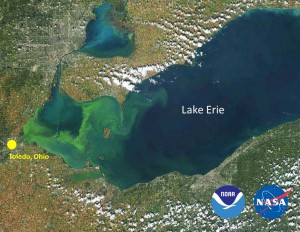This week, in response to increased demand for harmful algal bloom information, NOAA researchers and their partners at Heidelberg University began issuing new experimental, early season forecasts of the seasonal harmful algal bloom in western Lake Erie. The information will help resource and public health managers address the toxic blooms, which peak annually in late summer and can affect human and animal health.

The severity of western Lake Erie harmful algal blooms depends on the amount of phosphorus that comes in to the lake from March 1 through July 31, during what is known as the loading season. This early season forecast estimates the bloom severity based on measurements of phosphorus loading from the Maumee River combined with historical records to create the weekly estimates for the remainder of the loading season. They are also compared with NOAA satellite observations.
‘By using the environmental data collected by NOAA and our partners, resource managers in the Great Lakes can be better prepared for when harmful algal bloom events happen in their lakeshore communities,’ said Holly Bamford, Ph.D., assistant NOAA administrator for NOAA’s National Ocean Service performing duties of the assistant secretary of commerce for conservation and management. ‘As we continue to make advances in ecological forecasting and better understand the severity and timing of blooms, we can help local managers protect their residents and their economies.’
For more information, visit NCCOS HAB Forecasting or contact Richard.Stumpf@noaa.gov.
